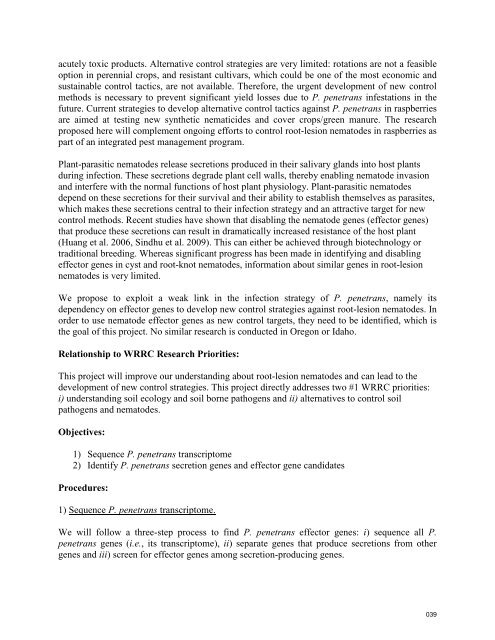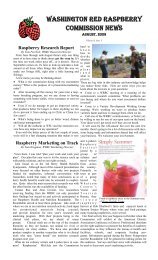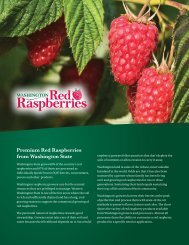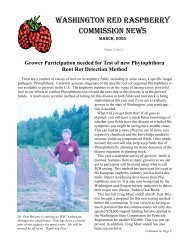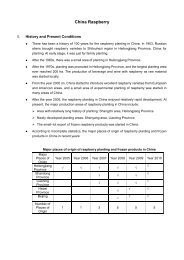2012 - Washington Red Raspberry Commission
2012 - Washington Red Raspberry Commission
2012 - Washington Red Raspberry Commission
You also want an ePaper? Increase the reach of your titles
YUMPU automatically turns print PDFs into web optimized ePapers that Google loves.
acutely toxic products. Alternative control strategies are very limited: rotations are not a feasible<br />
option in perennial crops, and resistant cultivars, which could be one of the most economic and<br />
sustainable control tactics, are not available. Therefore, the urgent development of new control<br />
methods is necessary to prevent significant yield losses due to P. penetrans infestations in the<br />
future. Current strategies to develop alternative control tactics against P. penetrans in raspberries<br />
are aimed at testing new synthetic nematicides and cover crops/green manure. The research<br />
proposed here will complement ongoing efforts to control root-lesion nematodes in raspberries as<br />
part of an integrated pest management program.<br />
Plant-parasitic nematodes release secretions produced in their salivary glands into host plants<br />
during infection. These secretions degrade plant cell walls, thereby enabling nematode invasion<br />
and interfere with the normal functions of host plant physiology. Plant-parasitic nematodes<br />
depend on these secretions for their survival and their ability to establish themselves as parasites,<br />
which makes these secretions central to their infection strategy and an attractive target for new<br />
control methods. Recent studies have shown that disabling the nematode genes (effector genes)<br />
that produce these secretions can result in dramatically increased resistance of the host plant<br />
(Huang et al. 2006, Sindhu et al. 2009). This can either be achieved through biotechnology or<br />
traditional breeding. Whereas significant progress has been made in identifying and disabling<br />
effector genes in cyst and root-knot nematodes, information about similar genes in root-lesion<br />
nematodes is very limited.<br />
We propose to exploit a weak link in the infection strategy of P. penetrans, namely its<br />
dependency on effector genes to develop new control strategies against root-lesion nematodes. In<br />
order to use nematode effector genes as new control targets, they need to be identified, which is<br />
the goal of this project. No similar research is conducted in Oregon or Idaho.<br />
Relationship to WRRC Research Priorities:<br />
This project will improve our understanding about root-lesion nematodes and can lead to the<br />
development of new control strategies. This project directly addresses two #1 WRRC priorities:<br />
i) understanding soil ecology and soil borne pathogens and ii) alternatives to control soil<br />
pathogens and nematodes.<br />
Objectives:<br />
1) Sequence P. penetrans transcriptome<br />
2) Identify P. penetrans secretion genes and effector gene candidates<br />
Procedures:<br />
1) Sequence P. penetrans transcriptome.<br />
We will follow a three-step process to find P. penetrans effector genes: i) sequence all P.<br />
penetrans genes (i.e., its transcriptome), ii) separate genes that produce secretions from other<br />
genes and iii) screen for effector genes among secretion-producing genes.<br />
039


